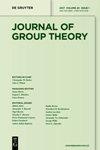有限域上的代数群:子群与同生之间的联系
IF 0.5
3区 数学
Q4 MATHEMATICS
引用次数: 0
摘要
摘要设𝐺是定义在有限域F q \mathbb{F} _q{上的一个线性代数群。我们给出了𝐺的等同性与有理点(G≠(F q n)) n≥1 (G(}\mathbb{F} _ {\smash{q^{n}}})){_n\geq 1的有限群之间的几个联系}。我们证明了一个同形形φ: G '→G\phi\colon G^ {\prime}\to G / F q \mathbb{F} _q{在无穷多个𝑛中产生一个固定指标的子群G(F q n) G(}\mathbb{F} _ {\smash{q^{n}}})。反之,我们证明了如果𝐺是约化的,那么对于无穷多个𝑛,固定指标𝑘的子群H {n H_n}的存在意味着存在一个𝑘阶的同工。特别地,我们证明了无限序列{hn_h_n}被有限个同基因所覆盖。这一结果适用于经典群GL m \mathrm{GL} _m{、SL m }\mathrm{SL} _m{、SO m }\mathrm{SO} _m{、SU m }\mathrm{SU} _m{、Sp 2±m }\mathrm{Sp} _2m{,如果𝑘是特征的素数,则可以推广到非约化群。作为一种特殊情况,我们看到,如果𝐺是单连通的,那么G¹(F q n) G(}\mathbb{F} _ {\smash{q^{n}}})的固有子群的最小指标发散到无穷大。通过改变特征𝑝,对序列(G¹(F p)) p (G(\mathbb{F} _p{))}_p{也得到了类似的结果。}本文章由计算机程序翻译,如有差异,请以英文原文为准。
Algebraic groups over finite fields: Connections between subgroups and isogenies
Abstract Let 𝐺 be a linear algebraic group defined over a finite field F q \mathbb{F}_{q} . We present several connections between the isogenies of 𝐺 and the finite groups of rational points ( G ( F q n ) ) n ≥ 1 (G(\mathbb{F}_{\smash{q^{n}}}))_{n\geq 1} . We show that an isogeny ϕ : G ′ → G \phi\colon G^{\prime}\to G over F q \mathbb{F}_{q} gives rise to a subgroup of fixed index in G ( F q n ) G(\mathbb{F}_{\smash{q^{n}}}) for infinitely many 𝑛. Conversely, we show that if 𝐺 is reductive, the existence of a subgroup H n H_{n} of fixed index 𝑘 for infinitely many 𝑛 implies the existence of an isogeny of order 𝑘. In particular, we show that the infinite sequence H n H_{n} is covered by a finite number of isogenies. This result applies to classical groups GL m \mathrm{GL}_{m} , SL m \mathrm{SL}_{m} , SO m \mathrm{SO}_{m} , SU m \mathrm{SU}_{m} , Sp 2 m \mathrm{Sp}_{2m} and can be extended to non-reductive groups if 𝑘 is prime to the characteristic. As a special case, we see that if 𝐺 is simply connected, the minimal indices of proper subgroups of G ( F q n ) G(\mathbb{F}_{\smash{q^{n}}}) diverge to infinity. Similar results are investigated regarding the sequence ( G ( F p ) ) p (G(\mathbb{F}_{p}))_{p} by varying the characteristic 𝑝.
求助全文
通过发布文献求助,成功后即可免费获取论文全文。
去求助
来源期刊

Journal of Group Theory
数学-数学
CiteScore
1.00
自引率
0.00%
发文量
45
审稿时长
6 months
期刊介绍:
The Journal of Group Theory is devoted to the publication of original research articles in all aspects of group theory. Articles concerning applications of group theory and articles from research areas which have a significant impact on group theory will also be considered.
Topics:
Group Theory-
Representation Theory of Groups-
Computational Aspects of Group Theory-
Combinatorics and Graph Theory-
Algebra and Number Theory
 求助内容:
求助内容: 应助结果提醒方式:
应助结果提醒方式:


